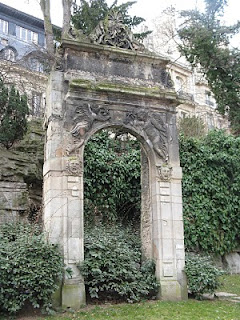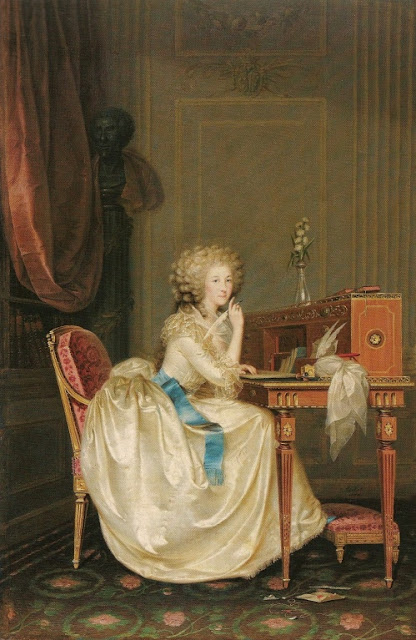Hyde and Seek
I'm looking for the truth. How sure can one be that a memoir published after a person's death is authentic? The Secret Memoirs of the Princesse de Lamballe edited by Catherine Hyde is a case in point. According to Catherine Hyde, it was through the fact that she was a music student of the composer Sacchini that she came to the attention of the Lamballe and Marie Antoinette. Catherine records modestly, "when one day teaching Maria Antoinette, he so highly overrated to that illustrious lady my infant natural talents and acquired science in his arts , in the presence of her very shadow, the Princess Lamballe, as to excite in Her Majesty and eager desire for the opportunity of hearing me…" The Princesse de Lamballe went to the rue de Bacq convent in which Catherine lived and studied, to hear her play and was impressed. The young woman spoke four languages and, what's more, was converting to Catholicism and must've seemed to be the kind of girl that could keep a secret, because the Lamballe employed her for a variety of assignments. Or, as Catherine wrote, "I became the protégé of this ever-regretted angel."
Catherine became something of an all-purpose Fille Vendredi. (I'm sinking low with that one.) During the Revolution and the years that the Royal Family and their attendants, including the Princesse de Lamballe, were at the Tuileries and Tower, she was a courier, a spy, an errand-girl within France and abroad. In this capacity, she was "repeatedly a witness, by the side of the Princess Lamballe, of the appalling scenes… when the Queen was generally selected as the most marked victim of malicious indignity. Having had the honor of so often beholding this much-injured Queen and never without remarking how amiable in her manners, how condescendingly kind in her deportment toward everyone about her, how charitably generous, and withal, how beautiful she was; I looked upon her as a model of perfection."
Catherine describes how the Princesse, only months before her death, delivered the journal into her hands in a private alley of the Tuileries, for her to read and protect. Catherine supplemented it with her observations and memories and, violà, a glorious evening reading the events of the French Revolution as seen through the eyes of the Princesse de Lamballe and her secret agent.
The top three pictures are of the remains of the burned Tuileries Palace. They're practically unmarked in an obscure park in Paris. If not for Elissa, I'd not be aware of them. Their existance hasn't been mentioned in anything I've read.
I was standing on the former location of the Tuileries when I took the picture of the Eiffel Tower in the snow last March. The Tuileries was the fourth side of the square formed that was formed by it and the Louvre. The engraving is of the Tuileries before it burned down. Behind it, in the distance, are the Obelisk, standing in what is now know as the Place de Concorde, and beyond that, the Arc de Triomphe.
The cuter-in-real-life orange, waterproof shoes are on my feet standing on the snowy ground on which the Tuileries stood before it was burned down in 1871.
I confess. The title of this post was stolen from a post on Marie Antoinette forum.
http://forum.marie-antoinette.org/viewtopic.php?p=6373
Catherine became something of an all-purpose Fille Vendredi. (I'm sinking low with that one.) During the Revolution and the years that the Royal Family and their attendants, including the Princesse de Lamballe, were at the Tuileries and Tower, she was a courier, a spy, an errand-girl within France and abroad. In this capacity, she was "repeatedly a witness, by the side of the Princess Lamballe, of the appalling scenes… when the Queen was generally selected as the most marked victim of malicious indignity. Having had the honor of so often beholding this much-injured Queen and never without remarking how amiable in her manners, how condescendingly kind in her deportment toward everyone about her, how charitably generous, and withal, how beautiful she was; I looked upon her as a model of perfection."
Catherine describes how the Princesse, only months before her death, delivered the journal into her hands in a private alley of the Tuileries, for her to read and protect. Catherine supplemented it with her observations and memories and, violà, a glorious evening reading the events of the French Revolution as seen through the eyes of the Princesse de Lamballe and her secret agent.
The top three pictures are of the remains of the burned Tuileries Palace. They're practically unmarked in an obscure park in Paris. If not for Elissa, I'd not be aware of them. Their existance hasn't been mentioned in anything I've read.
I was standing on the former location of the Tuileries when I took the picture of the Eiffel Tower in the snow last March. The Tuileries was the fourth side of the square formed that was formed by it and the Louvre. The engraving is of the Tuileries before it burned down. Behind it, in the distance, are the Obelisk, standing in what is now know as the Place de Concorde, and beyond that, the Arc de Triomphe.
The cuter-in-real-life orange, waterproof shoes are on my feet standing on the snowy ground on which the Tuileries stood before it was burned down in 1871.
I confess. The title of this post was stolen from a post on Marie Antoinette forum.
http://forum.marie-antoinette.org/viewtopic.php?p=6373







Comments